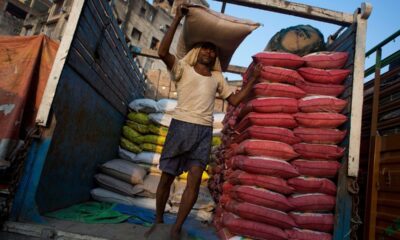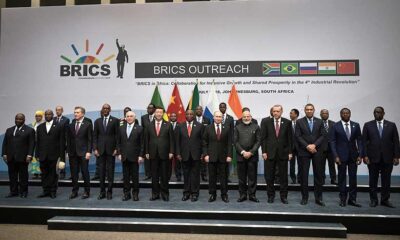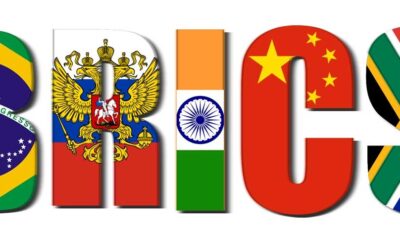BUSINESS & ECONOMY
Blue Economy for Revitalization of Oceans
Published
10 months agoon
By
Editor
By Ahmad Ibrahim
Oceans are custodian of life on planet Earth and have shaped human civilization since millennia. Enveloping over 70% of planet’s surface, oceans regulate weather and climate patterns. More than 70% of earth oxygen generation is undertaken by algae in oceans. Humanity has depended on oceans for sustenance, progression, and survival. The rapid growth in human population and subsequent increment of human economic foot print is straining our continental resources. The menace of pollution is damaging our planet, putting the human well-being and even existence in danger. This has necessitated restructuring the way we interact with our planet in general and oceans in particular. As humanity’s relationship with the ocean is getting increasingly demanding, therefore, new concepts are needed for revitalization of oceans in the way which is sustainable, progressive, and secure.
Blue Economy provides the framework for synchronization of economic prosperity with the sustainability of nature. First coined by Gunter Pauli, the lynchpin of Blue Economy is sustainability. It deals with sustainable use of oceans for improved livelihood and economic growth without compromising the ocean health. Blue Economic model has direct compatibility with five Sustainable Development Goals (SDGs) crafted by United Nations. These five SDGs include eradication of poverty (SDG-01), ensuring of good health and well-being (SDG-03), emphasis on innovation and infrastructure development (SDG-09), undertaking climate action (SDG-13) and safeguarding of life below water (SDG-14).
The potential of the Blue Economy is enormous. In 2010, the Global Oceanic Economy was valued at approximately 1.5 trillion USD, and by 2030, it is expected to surpass the 3 trillion USD mark. The net worth of Oceanic assets is estimated to be 24 trillion USD. Oceanic resources are vast but not unlimited. Therefore, sustenance of resources is essential. Blue Economy offers more reliable and credible alternative to traditional ocean based economic model. It deals with maritime economic professions like fisheries, resource extraction, marine transportation, and tourism, but within the bindings of ecofriendly regulations. Plus, it incorporates practices, like aquaculture/mariculture, blue biotech, and renewable energy production from oceans, for improving productivity while retaining minimum impact on marine ecosystem.
One of the fundamental pillars of the Blue Economy is the promotion of sustainable fisheries. In 2022, global sea food market was valued more than 257 Billion USD. It’s projected to reach 350 Billion by 2027. Overfishing is rapidly depleting fish stocks and is disrupting marine ecosystems. To address the growing demand for seafood and alleviate pressure on wild fish stocks, the Blue Economy encourages the development of sustainable aquaculture and mariculture practices. These modern fish farming practises involve raising fish stocks and other marine lives like aquatic plants in controlled environment. By adopting these practises on global scale, we can reduce our reliance on wild fisheries while ensuring a consistent supply of seafood. In parallel, aquaculture and mariculture have the potential of generating more financial revenue than traditional fish catching practises. Currently Global aquaculture market is valued approximately USD 289.6 Billion and is expected to reach USD 421.2 Billion by end of 2030.
The Blue Economy recognizes the vast potential of oceans as a renewable energy source. Offshore wind farming, tidal, and wave energy offer a sustainable alternative to carbon-based energy sources. In practise, offshore wind turbines are more efficient than onshore wind turbines. Horsea Wind Farm, located roughly 89 kms off the coast of Yorkshire, UK, is currently the largest wind farm in world. It can produce 1.3 GW of clean energy. By middle of this century, European Union is targeting to achieve 300GW energy generation from offshore wind farming. Similarly, it is estimated that 120-400 GW energy can be made available to mankind through tidal waves alone. The International Energy Agency’s calculations suggest that ocean waves are capable of producing 8,000 – 80,000 TW yearly. Clean ocean energy technologies may have high capital cost, but by harnessing enormous power of oceans we will not only foster a clean energy transition but also fulfil our immense energy requirements for generations.
The Blue Economy encourages sustainable tourism practices that balance economic benefits with environmental conservation. The net contribution of global tourism and travel industry is approximately USD 5.8 trillion. Coastal and marine tourism constitute roughly half (50%) of net global tourism. These statistics proves that tourism is a major contributor to global economy, but its unregulated expansion can harm ecosystems. By promoting eco-friendly tourism, and marine conservation initiatives, we can create a positive feedback loop. Thriving ecosystems attract visitors, who, in turn, contribute to conservation efforts and generate revenue for local communities.
The Blue Economy also promotes marine biotechnology – a new technological sector. Marine ecosystem is predominately unexplored and has rich biodiversity. Marine organisms contain natural compounds which can be used for developing new products like biomaterials, biofuels, biomedicines, and other innovations etc. Many such bio products are already in use in the fields of health care, livestock, industrial manufacturing, and transportation. Moreover, this technology is now being used to enhance the productivity of aquaculture and mariculture. For entire marine biotechnology sector, it’s difficult to gauge its precise economic worth as it encompasses vast range of activities. Investing in research and development of marine biotechnology will not only drive economic growth but also contribute to the well-being of humanity and the conservation of marine ecosystems.
Since humanity is intrinsically tied to the oceans, it is in the individual’s best interest to act collectively to benefit from global commons. Such planning requires collaboration among local communities, industries, governments, and global organizations. Blue Economy has the potential to resolve our problems associated with economic growth and climate change. To protect and better utilize oceans in a sustainable manner, we must establish equilibrium – one rooted in true understanding of oceans and its relation with humanity. For that we have to periodically adopt sustainable fisheries, promote aquaculture, unlock renewable oceanic energy resources, harness marine biotechnology, practice responsible tourism, and implement effective governance. By bringing together our knowledge and efforts related to Blue Economy, we will be able revitalize our oceans and thus secure a better future. (1007)
Courtesy: Modern Diplomacy
You may like
BUSINESS & ECONOMY
ICD and JSC Ziraat Bank Collaborate to Boost Uzbekistan’s Private Sector
Published
2 days agoon
May 16, 2024By
Editor
At the 3rd Tashkent Investment Forum, the Islamic Corporation for the Development of the Private Sector (ICD) and JSC Ziraat Bank Uzbekistan took a significant step forward in their partnership to empower small and medium-sized enterprises (SMEs) and foster economic growth in Uzbekistan. The forum, held in the capital city of Uzbekistan, brought together key stakeholders from the public and private sectors to discuss investment opportunities and economic development strategies for the region. The collaboration between the Islamic Corporation for the Development of the Private Sector (ICD) and JSC Ziraat Bank Uzbekistan is aimed at boosting the private sector in Uzbekistan.
During the forum, ICD and JSC Ziraat Bank Uzbekistan formalized an expression of intent to collaborate on various initiatives aimed at supporting SMEs. One of the key elements of this collaboration is the provision of a Line of Financing (LoF) facility by ICD to JSC Ziraat Bank Uzbekistan. This LoF facility will enable the bank to fund private sector projects as an agent of ICD, thereby providing SMEs with access to the necessary capital to initiate and grow their businesses.
The partnership between ICD and JSC Ziraat Bank Uzbekistan is expected to have a significant impact on the SME landscape in Uzbekistan. By equipping entrepreneurs with the resources they need to succeed, this collaboration will not only support the growth of individual businesses but also contribute to the overall economic development of the country. SMEs play a crucial role in driving economic growth, creating jobs, and fostering innovation, and this partnership will help strengthen the SME ecosystem in Uzbekistan.
JSC Ziraat Bank Uzbekistan, as a strategic partner for ICD, brings a wealth of experience and expertise to the table. As a prominent commercial bank with foreign capital, JSC Ziraat Bank Uzbekistan has a strong track record of supporting SMEs and promoting economic development. The bank’s partnership with ICD further underscores its commitment to advancing the private sector in Uzbekistan and its dedication to supporting the country’s economic growth.
ICD, for its part, is a leading multilateral development financial institution that focuses on supporting the economic development of its member countries through the provision of finance and advisory services to private sector enterprises. By partnering with JSC Ziraat Bank Uzbekistan, ICD is furthering its mission of promoting economic development and fostering entrepreneurship in Uzbekistan and across the Islamic world.
The LoF facility provided by ICD to JSC Ziraat Bank Uzbekistan is just one example of the many initiatives that the two entities are undertaking to support SMEs in Uzbekistan. In addition to providing financial support, the partnership between ICD and JSC Ziraat Bank Uzbekistan will also include capacity-building initiatives and technical assistance programs to help SMEs succeed in today’s competitive business environment.
Overall, the partnership between ICD and JSC Ziraat Bank Uzbekistan represents a significant step forward in supporting SMEs and fostering economic growth in Uzbekistan. By working together, these two institutions are helping to create a more vibrant and dynamic private sector in Uzbekistan, which will ultimately benefit the country’s economy and its people. The collaboration between the Islamic Corporation for the Development of the Private Sector (ICD) and JSC Ziraat Bank Uzbekistan is expected to have a far-reaching impact on the private sector in Uzbekistan.
BUSINESS & ECONOMY
In Times of Conflict, Spare a Thought for the Non-Gulf Economies
Published
2 weeks agoon
May 6, 2024By
Editor
By James Swanston
Positive news for non-GCC Arab economies has been in short supply of late. The Gaza conflict, missile attacks in the Red Sea, war in Ukraine and last month’s tit-for-tat missile strikes between Israel and Iran have weighed on sentiment, undermined limited confidence and cut into growth.
But some positives have emerged. Headline inflation rates have slowed across much of North Africa and the Levant, implying lower interest rates, a return to real growth and more stable exchange rates. March data show inflation at an annualised rate of just 0.9 percent in Morocco and 1.6 percent in Jordan. Tunisia’s inflation rate has also come down, although it is still running at over 7 percent year on year.
Egypt’s inflation rate jumped earlier this year as the government implemented price hikes to some goods and services – notably fuel. In February, the effect of the devaluation in the pound to the level of the parallel market affected prices. But March’s reading eased to an albeit still high 33 percent year on year.
Elsewhere, Lebanon’s inflation slowed to 70 percent year on year in March, the first time it has been in double – rather than triple – digits since early 2020 due to de-facto dollarisation and lower demand for imports. That said, inflation in these economies is vulnerable to increases in the prices of global foods and energy (such as oil) due to their being net importers. If supply chain disruptions persist, it could result in central banks keeping monetary policy tighter with consequences for growth and employment. And in Morocco’s case, it could undermine the Bank Al-Maghrib’s intention to widen the dirham’s trading band and formally adopt an inflation-targeting monetary framework.
The strikes by Iran and Israel undoubtedly marked a dangerous escalation in what up to now had been a proxy war. Thankfully, policymakers across the globe have for the moment worked to de-escalate the situation. Outside the countries directly involved, the most significant spillover has been the disruptions to shipping in the Red Sea and Suez Canal. Many of the major global shipping companies have diverted ships away from the Red Sea due to attacks by Houthi rebels and have instead opted to go around the Cape of Good Hope.
The latest data shows that total freight traffic through the Suez Canal and Bab el-Mandeb Strait is down 60-75 percent since the onset of the hostilities in Gaza in early October. Almost all countries have seen fewer port calls. This could create fresh shortages of some goods imports, hamper production, and put upward pressure on prices.
For Egypt, inflation aside, the shipping disruptions have proven to be a major economic headache. Receipts from the Suez Canal were worth around 2.5 percent of GDP in 2023 – and that was before canal fees were hiked by 15 percent this January. Canal receipts are a major source of hard currency for Egypt and officials have said that revenues are down 40-50 percent compared to levels in early October.
The conflict is also weighing on the crucial tourism sector. Tourism accounts for 5-10 percent of GDP in the economies of North Africa and the Levant and is a critical source of hard currency inflows.
Jordan, where figures are the timeliest, show that tourist arrivals were down over 10 percent year on year between November and January. News of Iranian drones and missiles flying over Jordan imply that these numbers will, unfortunately, have fallen further.
In the case of Egypt, foreign currency revenues – from tourism and the Suez canal – represent more than 6 percent of GDP and are vulnerable. This played a large part in the decision to de-value the pound and hike interest rates aggressively in March.
The saving grace is that the conflict has galvanised geopolitical support for these economies. For Egypt, the aforementioned policy shift was accompanied by an enhanced $8bn IMF deal and, while not strictly bilateral support, the bumper Ras el-Hekma deal seems to have been accelerated as the pressure on the Egyptian economy ratcheted up. This is providing much needed foreign currency. At the same time, Jordan recently renewed its financing arrangement with the IMF for $1.2bn over four years.
Tunisia, however, is an exception. President Saied’s anti-IMF rhetoric and reluctance to pass reforms, such as harsh fiscal consolidation, in an election year, mean that the country’s staff-level agreement for an IMF deal is likely to remain in limbo. If strains on Tunisia’s foreign receipts are stretched, and the central bank and government continue with unorthodox policies of deficit financing, there is a risk that Tunisia’s economic crisis will become messier more quickly in the next year – particularly large sovereign debt repayments are due in early 2025.
James Swanston is Middle East and North Africa economist at London-based Capital Economics
BUSINESS & ECONOMY
Debt Dependency in Africa: the Drivers
Published
2 weeks agoon
May 6, 2024By
Editor
In mid-April Ghana’s efforts to restructure its sovereign debt came to nothing, increasing the risk that it couldn’t keep up with its repayments. This is a familiar story for many African countries. Twenty of them are in serious debt trouble. Carlos Lopes argues that there are three factors driving this state of affairs: the rules of the international banking system; lenders’ focus on poverty reduction rather than development needs; and unfair treatment by rating agencies.
The debt situation in many African countries has escalated again to a critical juncture. Twenty are in, or at risk of, debt distress. Three pivotal elements significantly contribute to this. Firstly, the rules governing the international banking system favour developed countries and work against the interests of African countries.
Secondly, multilateral financial institutions such as the International Monetary Fund (IMF) and the World Bank focus on poverty alleviation. This is commendable. But it doesn’t address the liquidity crisis countries face. Many don’t have the necessary readily available funds in their coffers to cover urgent development priorities due to their dependency on volatile commodity exports. As a result governments turn to raising sovereign debt under conditions that are among the most unfavourable on the planet. This perpetuates a debt dependency cycle rather than fostering sustainable economic growth.
Thirdly, there’s the significant influence of biased credit rating agencies. These unfairly penalise African countries. In turn, this impedes their ability to attract investment on favourable terms. The convergence of these three factors underscores the imperative to implement effective strategies aimed at mitigating the overwhelming debt burden afflicting African nations. These strategies must address the immediate financial challenges facing countries. They must also lay the groundwork for long-term economic sustainability and equitable development across the continent.
By tackling these issues head-on, a financial environment can be created that fosters growth, empowers local economies, and ensures that African countries have access to the resources they need to thrive.
Rules of the banking game
The Bank for International Settlements is often called the “central bank for central banks”. It sets the regulations and standards for the global banking system. But its rules disproportionately favour developed economies, leading to unfavourable conditions for African countries. For instance, capital adequacy requirements – the amount of money banks must hold in relation to their assets – and other prudential rules may be disproportionately stringent for African markets. This limits lending to stimulate economic growth in less attractive economies.
The bank’s policies also often overlook developing nations’ unique challenges. Following the 2008/2009 financial crisis, the bank introduced a new, tougher set of regulations. Their complexity and stringent requirements have inadvertently accelerated the withdrawal of international banks from Africa.
They have also made it increasingly difficult for global banks to operate profitably in African markets. As a result, many have chosen to scale back their operations, or exit. The withdrawals have reduced competition within the banking sector, limited access to credit for businesses and individuals, and hampered efforts to promote economic growth and development.
The limitations of the new regulations highlight the need for a more nuanced approach to banking regulation. The adverse effects could be mitigated by simplifying the regulations. For example, requirements could be tailored to the specific needs of African economies, and supporting local banks.
Focus on poverty alleviation
Multilateral financial institutions like the IMF and the World Bank play a crucial role in providing financial assistance to many countries on the continent. But their emphasis on poverty alleviation and, more recently, climate finance often overlooks the urgent spending needs. Additionally, the liquidity squeeze facing countries further limits their capacity to prioritise essential expenditure. Wealthy nations enjoy the luxury of lenient regulatory frameworks and ample fiscal space. For their part African countries are left to fend for themselves in an environment rife with predatory lending practices and exploitative economic policies. Among these are sweetheart tax deals which often involving tax exemptions. In addition, illicit financial practices by multinational corporations drain countries of their limited resources. Research by The ONE Campaign found that financial transfers to developing nations plummeted from a peak of US$225 billion in 2014 to just US$51 billion in 2022, the latest year for which data is available. These flows are projected to diminish further.
Alarmingly, the ONE Campaign report stated that more than one in five emerging markets and developing countries allocated more resources to debt servicing in 2022 than they received in external financing. Aid donors have been touting record global aid figures. But nearly one in five aid dollars was directed towards domestic spending hosting migrants or supporting Ukraine. Aid to Africa has stagnated.
This leaves African countries looking for any opportunities to access liquidity, which makes them a prey of debt scavengers. As noted by Columbia University professor José Antonio Ocampo, the Paris Club, the oldest debt-restructuring mechanism still in operation, exclusively addresses sovereign debt owed to its 22 members, primarily OECD countries.
With these limited attempts to address a significant structural problem of pervasive indebtedness it is unfair to stigmatise Africa as if it contracted debt because of its performance or bad management.
Rating agencies
Rating agencies wield significant influence in the global financial landscape. They shape investor sentiment and determine countries’ borrowing costs. However, their assessments are often marked by bias. This is particularly evident in their treatment of African countries. African nations argue that without bias, they should receive higher ratings and lower borrowing costs. In turn this would mean brighter economic prospects as there is a positive correlation between financial development and credit ratings. However, the subjective nature of the assessment system inflates the perception of investment risk in Africa beyond the actual risk of default. This increases the cost of credit.
Some countries have contested ratings. For instance, Zambia rejected Moody’s downgrade in 2015, Namibia appealed a junk status downgrade in 2017 and Tanzania appealed against inaccurate ratings in 2018. Ghana contested ratings by Fitch and Moody’s in 2022, arguing they did not reflect the country’s risk factors. Nigeria and Kenya rejected Moody’s rating downgrades. Both cited a lack of understanding of the domestic environment by rating agencies. They asserted that their fiscal situations and debt were less dire than estimated by Moody’s.
Recent arguments from the Economic Commission for Africa and the African Peer Review Mechanism highlight deteriorating sovereign credit ratings in Africa despite some posting growth patterns above 5% for sustained periods. Their joint report identifies challenges during the rating agencies’ reviews. This includes errors in publishing ratings and commentaries and the location of analysts outside Africa to circumvent regulatory compliance, fees and tax obligations.
A recent UNDP report illuminates a staggering reality: African nations would gain a significant boost in sovereign credit financing if credit ratings were grounded more in economic fundamentals and less in subjective assessments. According to the report’s findings, African countries could access an additional US$31 billion in new financing while saving nearly US$14.2 billion in total interest costs.
These figures might seem modest in the eyes of large investment firms. But they hold immense significance for African economies. If credit ratings accurately reflected economic realities, the 13 countries studied could unlock an extra US$45 billion in funds. This is equivalent to the entire net official development assistance received by sub-Saharan Africa in 2021. These figures underscore the urgent need to address the systemic biases plaguing credit rating assessments in Africa.
Next steps
Debates about Africa’s debt crisis often lean towards solutions centered on compensation. These advocate for increased official development aid, more generous climate finance measures, or the reduction of borrowing costs through hybrid arrangements backed by international financial systems. These measures may offer temporary relief. But they need to be more genuine solutions in light of the three structural challenges facing African countries.
Carlos Lopes,a Professor at the Nelson Mandela School of Public Governance, University of Cape Town, is the Chair of the African Climate Foundation’s Advisory Council as well as its Chairman of the Board. He is also a board member of the World Resources Institute and Climate Works Foundation.
Courtesy: The Conversation

Red Notice: Putin is Nearby

We are not Yet Winning, but they are Losing

HLISB Introduces BizHalal To Support SMEs in the Global Halal Market
Topics
- AGRIBUSINESS & AGRICULTURE
- BUSINESS & ECONOMY
- DIGITAL ECONOMY & TECHNOLOGY
- EDITORIAL
- ENERGY
- EVENTS & ANNOUNCEMENTS
- HALAL ECONOMY
- HEALTH & EDUCATION
- IN CASE YOU MISSED IT
- INTERNATIONAL POLITICS
- ISLAMIC FINANCE & CAPITAL MARKETS
- KNOWLEDGE CENTRE, CULTURE & INTERVIEWS
- OBITUARY
- OPINION
- PROFILE
- PUBLICATIONS
- SPECIAL FEATURES/ECONOMIC FOOTPRINTS
- SPECIAL REPORTS
- SUSTAINABILITY & CLIMATE CHANGE
- THIS WEEK'S TOP STORIES
- TRENDING
- UNCATEGORIZED
- UNITED NATIONS SDGS
Trending
-

 TRENDING12 months ago
TRENDING12 months agoAFRIEF Congratulates New Zamfara State Governor
-

 PROFILE9 months ago
PROFILE9 months agoA Salutary Tribute to General Ibrahim Badamasi Babangida: Architect of Islamic Finance in Nigeria
-

 BUSINESS & ECONOMY3 years ago
BUSINESS & ECONOMY3 years agoClimate Policy In Indonesia: An Unending Progress For The Future Generation
-

 BUSINESS & ECONOMY3 years ago
BUSINESS & ECONOMY3 years agoThe Climate Crisis is Now ‘Code Red’: We Can’t Afford to Wait Any Longer
-

 BUSINESS & ECONOMY3 years ago
BUSINESS & ECONOMY3 years agoIPCC report: ‘Code red’ for human driven global heating
-

 HALAL ECONOMY10 months ago
HALAL ECONOMY10 months agoRevolutionizing Halal Education Through Technology
-

 SPECIAL REPORTS5 months ago
SPECIAL REPORTS5 months agoRemembering Maryam Ibrahim Babangida: A Legacy of Grace, Philanthropy, and Leadership
-

 BUSINESS & ECONOMY3 years ago
BUSINESS & ECONOMY3 years agoDistributed Infrastructure: A Solution to Africa’s Urbanization











